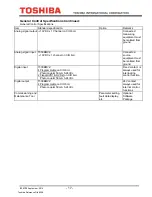
IF08CZ9 September, 2019
- 5 -
INSPECTIONS AND MAINTENANCE
(cont’d)
Main Components
1) Cooling fan - Check to see if there is any abnormality with airflow, increased fan noise, etc.
2) Air filter - Visually check if the air filter is clogged. Gently tap it outside the room to remove loose
dust. To remove caked on dirt use water and a gentle detergent, rinse it with clean water and dry it.
Otherwise replace it with a new one.
Cleaning with solvents is not recommended.
3) Main circuit parts and entire cubicle - Check to see if dust is stuck to the cubicle interior or if there
is any discoloration, heat generation, abnormal sound, leakage, odor or damage with the reactor,
transformer, contactors, cables and connections, fuses, capacitors, lightening arrestors, and
resistors. Check to see that no wires or mounted parts are broken, disconnected, loose or
damaged. High voltage standoffs, insulators, and cable can be cleaned with isopropyl alcohol.
4) Printed Wiring Boards - The boards, which are made up of ICs and electronic components, must
be protected from dust, corrosive gases and extreme temperatures. Pay attention to the installation
environment of the equipment. Regular inspections, the proper cleaning, and maintenance in an
optimal environment is essential for circuit boards. Since most of the components and parts are
small and vulnerable to external forces, when cleaning them, use a brush to carefully wipe off dust.
Inspect the boards for signs of component damage, heating, and corrosion.
Cautions on Handling Printed Wiring Boards
a) All maintenance work on the board should be carried out at least 15 minutes after all
power supplies are turned off to allow the capacitors on the boards to discharge.
b) When removing the board, disconnect all the connectors and wires and remove the
mounting screws from the upper part of the board first. At this time, be careful not to drop
the boards or screws. When setting the board down, place it on a static free surface. Be
careful not to damage any components.
c) When attaching the board, do so in the order opposite to the removing procedure. Be
sure that all of the connectors and wires are connected correctly.
d) New boards are shipped in an anti-static bag. Use this bag to store them.
Note that the anti-static coating is only on the inner side of the bag.
5) Check the protection functions for proper operation (Door switches, OH, E-stop...)
6) Check the insulation resistance of the medium voltage circuits.
CAUTION
Toshiba Reference File #328
















































